Hundreds of thousands of visitors every year at the Uffizi pass through the metal detectors on the ground floor, present their tickets, climb panting up the Grand Ducal Staircase (or take the elevator), arrive on the second floor where the tour begins, cross the Lorraine vestibule after which they hurl themselves to their left to dash, rightly, into the Hall of Majesties in order to admire the Madonnas of Giotto, Cimabue and Duccio in comparison and then from there continue onward. Almost no one retraces their steps: thus, almost no one gives a glance to the corner of the Corridoio di Levante overlooking Piazza della Signoria. Which is therefore, in fact, the least known and least visited part of the Uffizi. Despite the fact that it contains extremely interesting works, among which lie the history of the Uffizi, the history of Florence, and the vicissitudes of great collecting in the past.If you have plenty of time to visit the museum, it is therefore worth spending a few minutes to admire what this glimpse of the museum offers its visitors.
Beginning with a very spectacular and eye-catching sculptural group, that of Hercules felling the centaur Nessus, positioned in the center of the initial part of the East Corridor, just in front of the large windows facing the square. It is a work from the Roman period, and well conveys to the visitor the ideas about sculpture that were circulating in the 16th century, since the present appearance of the work is the result of restorations and additions of that time: in the 16th century, when ancient statues began to pour copiously into the collections of the great collectors of the time, it was quite normal to reintegrate the parts of an ancient statue that had been lost over time. And of this group at the time only the torso of Nessus and the base remained: a restoration was first attempted in Rome, but the final result, what we see today, was due to the inspiration of one of the greatest sculptors of the late 16th century, Giovanni Battista Caccini (Montopoli in Val d’Arno, 1556 - Rome, 1613), who added the Apuan marble parts to the docimeno marble of the find, which were added to what remained, creating an integration that still astonishes today for its ability to read the ancient and, consequently, for the intelligence with which Caccini was able to make the ancient converse with the modern. Consider that only the feet remained of the Hercules: the entire figure is the work of Caccini.
Moreover, in 2015 the group was restored by Paola Rosa with resources provided by the Friends of the Uffizi. According to the research of archaeologist Fabrizio Paolucci, head of the Uffizi’s classical statuary collection, the group, which has been in the halls of the institution since 1595 (the large building was opened in 1581), has been in the spot where we observe it today since 1790-1798 (we learn this from the gallery guides). Paolucci also emphasized the double portrait of two spouses in Italic marble that decorates the base and was intended for a funerary monument. “The portraits,” Paolucci explained, “are characterized by a crude realism in the rendering of the faces. The woman wears a simple scrimed hairstyle in the center, which finds correspondences in the oldest portrait type of Livia (last decades of the first century B.C.); the woman’s face is very florid, on her lips sintraved a smile. The man is depicted with short hair, forehead and eyebrows full of wrinkles, sunken eyes somewhat swollen and half-closed. The man’s features reveal a well-groomed person in appearance, aged, however, prematurely. It may be that this is one of the few funerary monuments, in which the surviving spouse, has her effigy reproduced next to that of her deceased husband.”
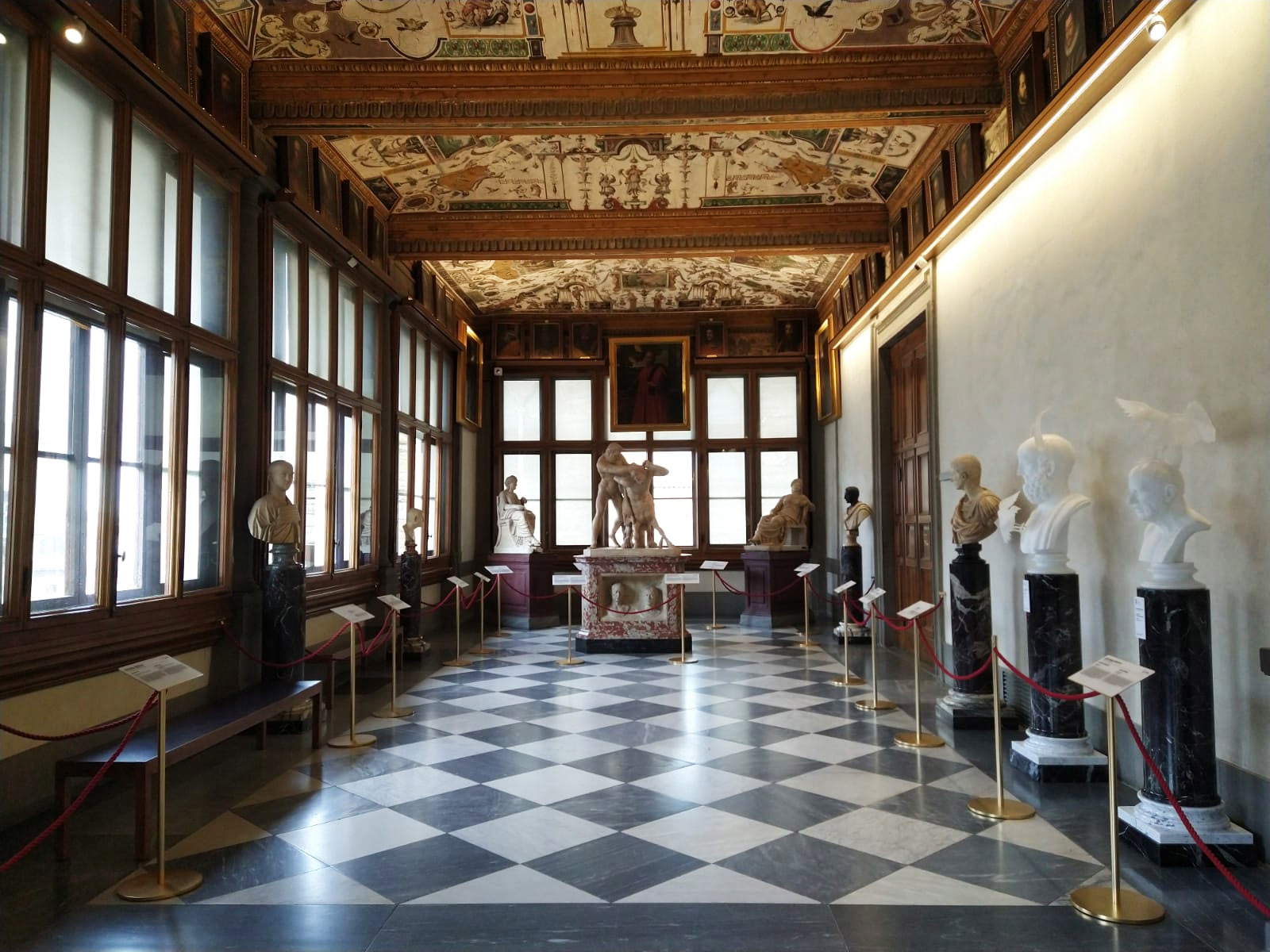

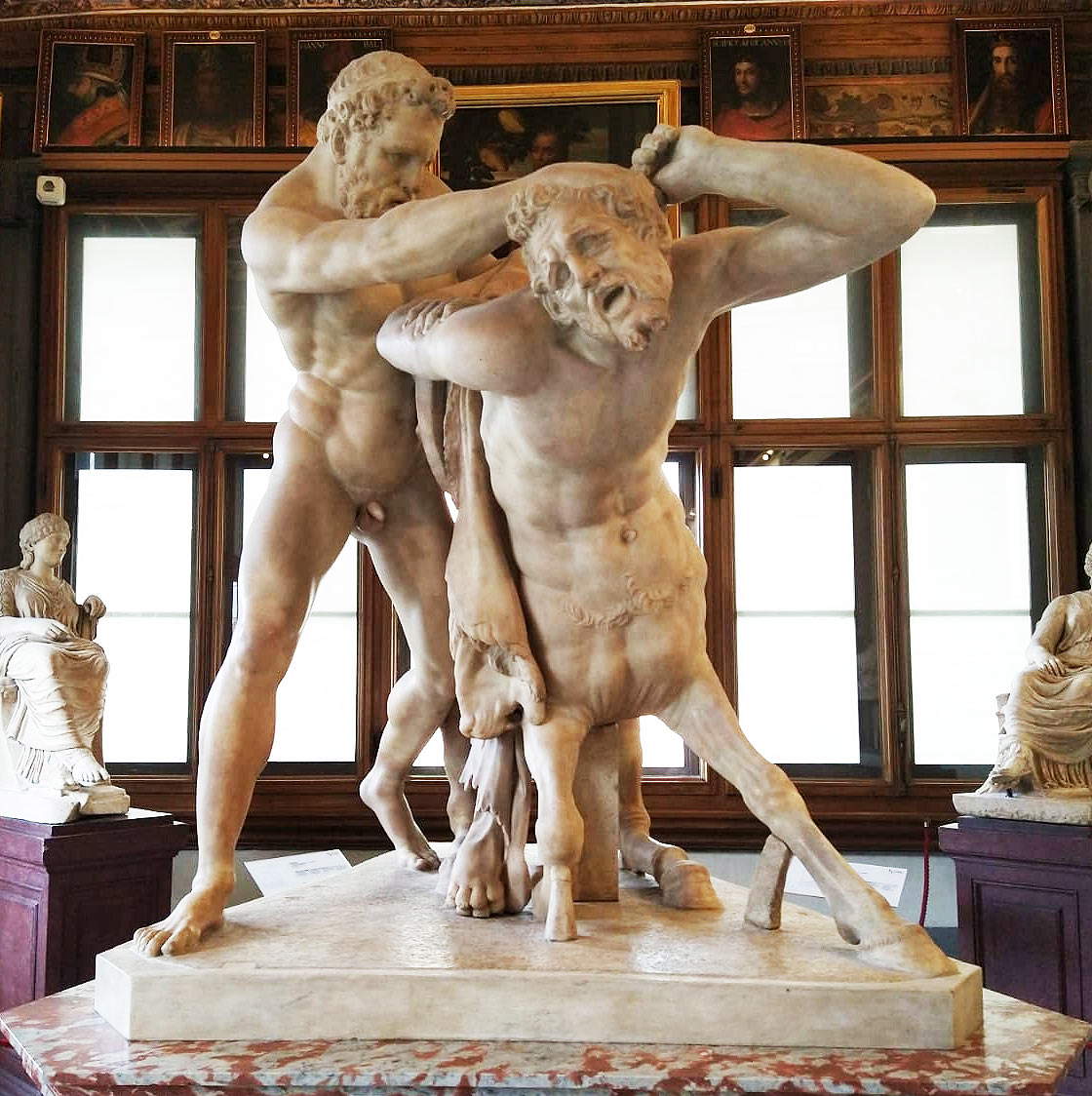
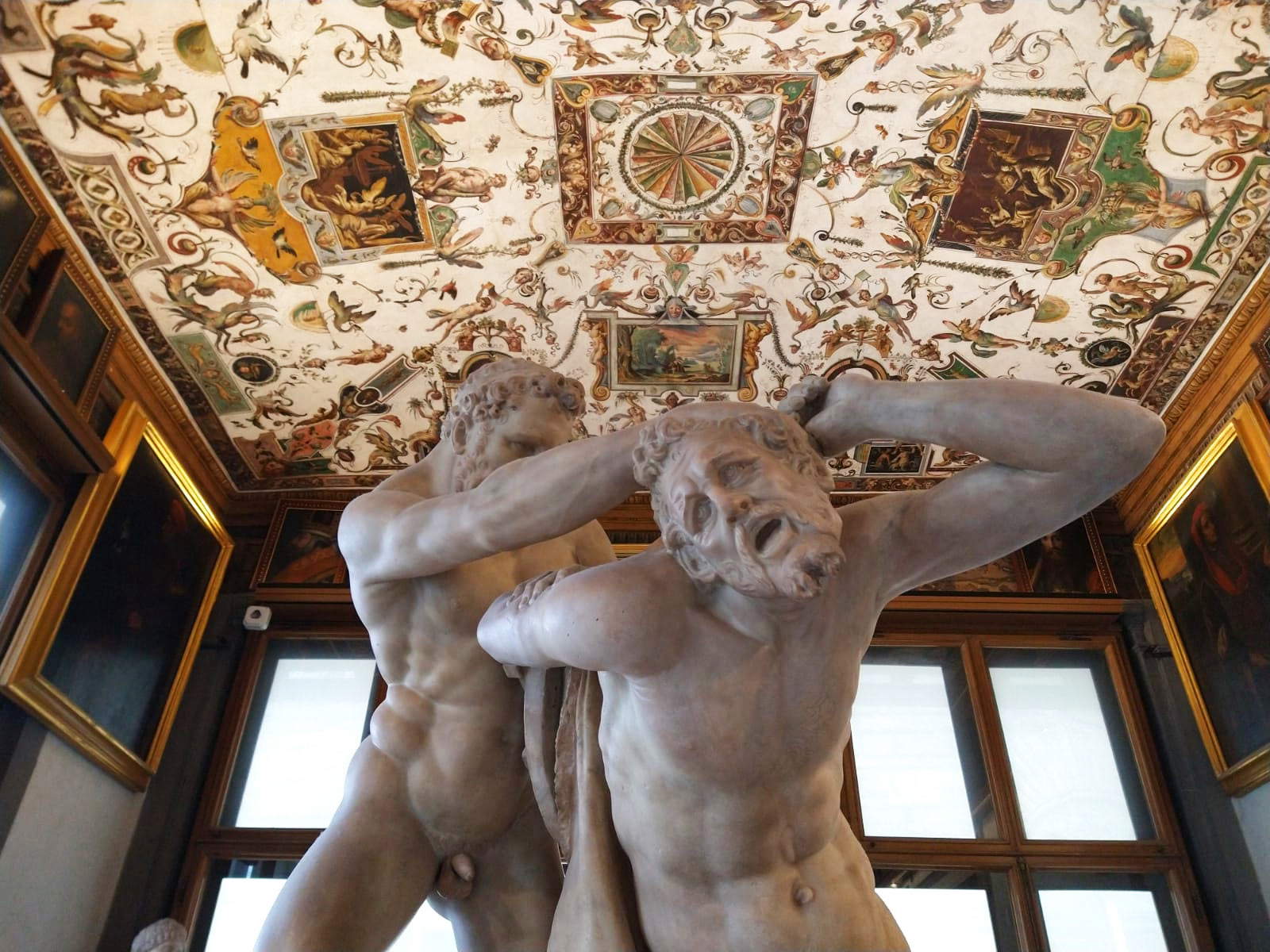
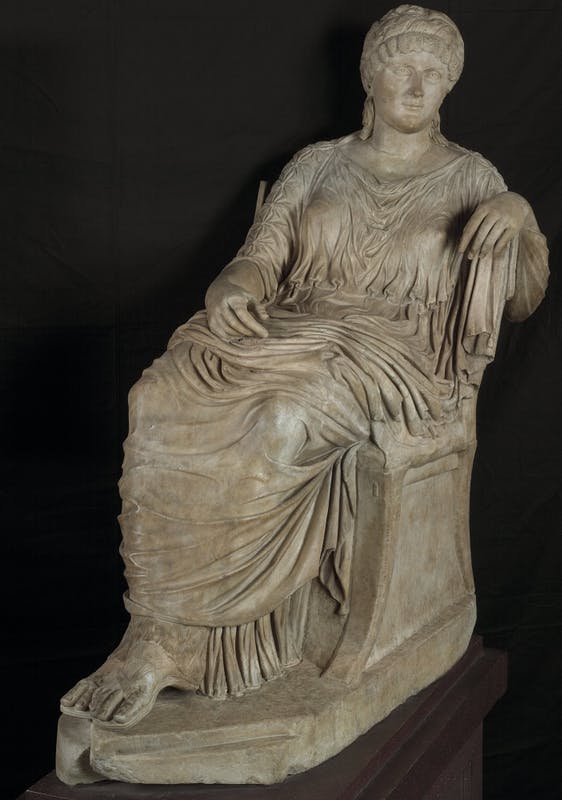
Just behind the group of Hercules felling the centaur Nessus are two significant female statues: a statue of an unidentified seated woman, and a portrait ofEmpress Helena. The seated woman, a Greek marble work by an Attic artist of the school of Phidias, is also the result of 16th-century additions (the head, neck, seat, feet, and fingers of the left hand). The Empress statue brings us back to the collecting events of the 16th century: it is possibly one of the sculptures found at Villa Adriana, and in ancient times was probably the property of Cardinal Ippolito II d’Este. It arrived in Florence towards the end of the 16th century and was first placed in the Boboli Gardens and then entered the Uffizi. It is one of the most admirable sculptures in the Uffizi’s ancient statuary collection because portraits of Helena, mother of Constantine, a figure dear to Christians in that she is venerated as a saint and believed to be the discoverer of the relic of the True Cross (as such, she is celebrated in Piero della Francesca ’s famous frescoes in the Bacci Chapel in Arezzo), are rare. In Pentelic marble, it finds another reason for interest in the fact that it is a second-century statue, possibly depicting Lucilla or Faustina Minor, reworked some two hundred years later to give it the features of Empress Helena.
Continuing to the rooms of paintings, one encounters a series of busts and portraits: two of these, a bust with a head of Gaius Caesar (formerly identified as Octavian: Gaius Caesar was his nephew) and a portrait of Agrippa, the latter positioned next to a bust of Tiberius, lead us back to late 15th-century diplomacy, as these were gifts that Pope Sixtus IV sent to Lorenzo the Magnificent. We can then admire a singular dark green marble portrait of Julius Caesar, possibly a 17th-century work, inspired by the so-called “Agliè” type (in fact, a portrait of the great leader found in Tusculum is preserved in the Castle of Agliè), and proposing a Caesar ahead of his years, portrayed just before the Ides of March. Not far from this work is the portrait of the so-called Cicero, found in Rome in the first half of the 17th century during construction work on the church of Sant’Ignazio, first donated to Cardinal Ludovico Ludovisi and then given in 1669 to Leopoldo de’ Medici. Also of considerable interest is the bust of Alexander Severus: Abbot Luigi Lanzi, a great art writer known for his Storia pittorica d’Italia, pointed to it as one of the best examples of the portraiture of the emperor, cousin of Heliogabalus. But in general there are many scholars who have dealt with this work, which is surprising because of its particular attire, a contabulata toga, typical of the late empire: it is one in which the front flap is raised and wrapped horizontally around the chest (instead of falling to one side as in the togas of more ancient times).


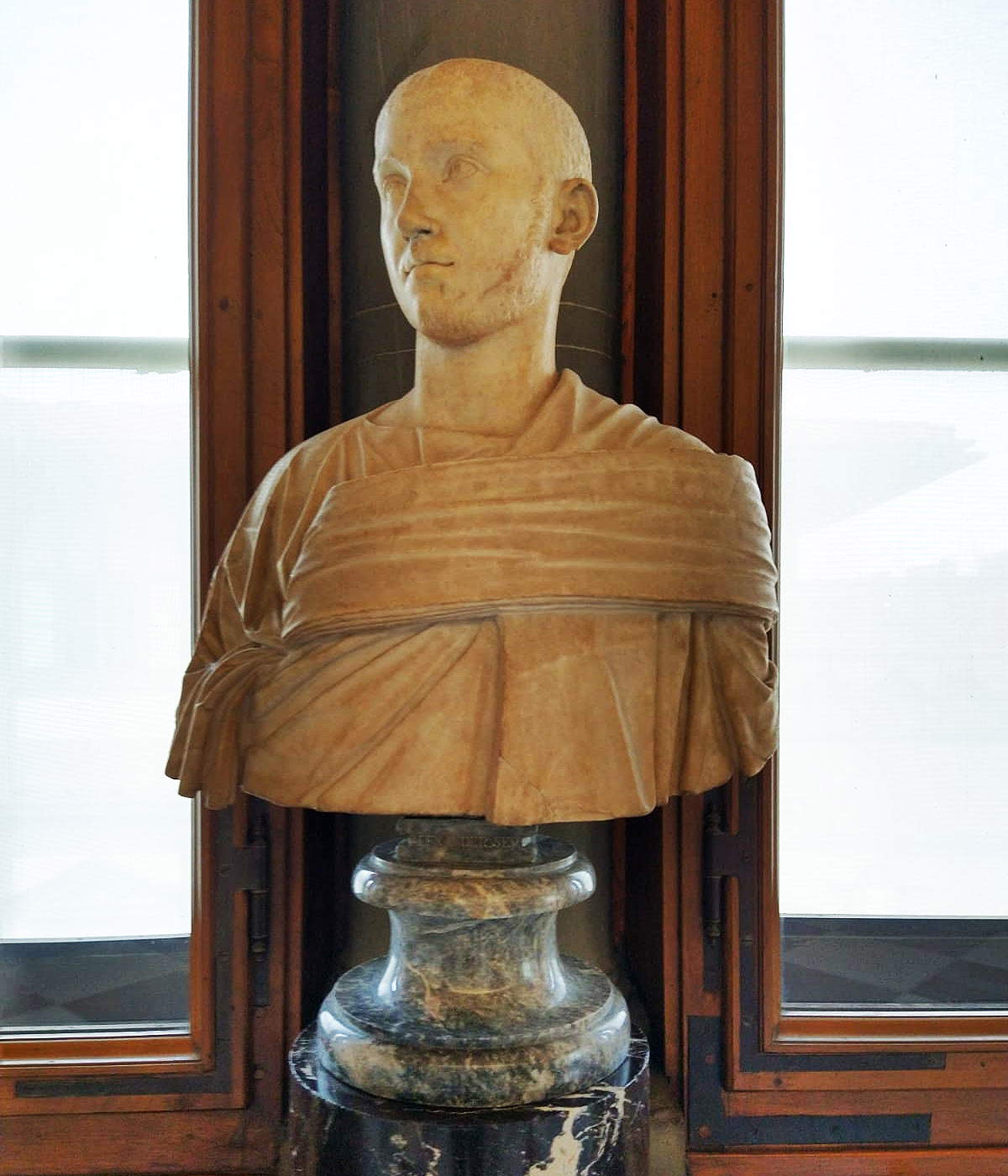



The parade of sculptures in the initial part of the Corridoio di Levante ends with two whole figures, a statue of Ceres and an Apollo “of the Omphalos”: the former is a Roman-era (late 1st or early 2nd century AD) replica of a bronze group from the late 4th century BC. We do not actually know for sure who the figure depicted is, but her clothing, and in particular the color of the latter (the robe is made of basanite, a black material, while the light-colored parts are made of Parian marble), fits well with an identification with the goddess of the harvest, since the somber tone of the robe would refer to the months of mourning, the months of winter, which the goddess spent without having her daughter Proserpine with her, who, according to mythology, spent six months of the year in the underworld with her husband Hades, while returning to earth for spring and summer. The Apollo, made of precious Pentelic marble, is probably a replica of a 480-440 B.C. Greek original from Calamis, and is of the type known as “of the Omphalos” in reference to the fact that one of the most intact specimens of this type of Apollo, preserved in the Archaeological Museum in Athens, is preserved on the base the sacred rock that was worshipped at Delphi (and was called omphalos, or “navel,” since the sanctuary was considered the center of the world).
As for the paintings, there hang on the walls some paintings from the Uffizi’s Serie Gioviana, the portrait gallery commissioned in 1552 from Cristofano dell’Altissimo by Cosimo I de’ Medici, who intended to have in Florence a replica of the sumptuous collection of portraits assembled in Como by Paolo Giovio (a collection that in fact constituted the first museum in the modern sense of history). And there are also some portraits from Alessandro Allori’s Serie Aulica, the gallery of portraits of the Medici commissioned by Francis I: right at the window hangs the portrait of the person who starts the series, Giovanni di Bicci. Then, if you look up to the ceiling, there you will also admire the frescoes by Antonio Tempesta. And after looking at the splendid grotesques and the Muse’s contention with the Pierides, one will be able to begin the journey to the rooms of paintings. With the idea of having begun the visit of the Uffizi from the song less known to most, but full of value and able to surprise.
Warning: the translation into English of the original Italian article was created using automatic tools. We undertake to review all articles, but we do not guarantee the total absence of inaccuracies in the translation due to the program. You can find the original by clicking on the ITA button. If you find any mistake,please contact us.